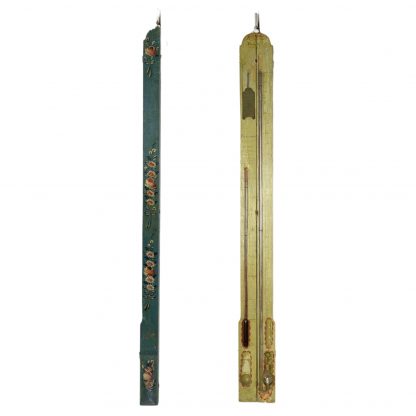  |
Louis XVI Portable Barometer Thermometer, French, Mid 18th Century
List: $4,500
Folding hinged portable barometer thermometer, French, Circa 1753. With painted florals on the exterior. Barometre Portatif - Portable barometer Thermomètre de Réaumur par Carcani constructeur de instruments de physique de son altesse Sérénissime Monseigneur le Prince de Condé. Grand rue du Faubourg St Antoine à côté de la fontaine Charonne. (Thermometer by Carcanï, maker of scientific instruments for His Serene Highness, Monseigneur le Prince de Condé, rue du Faubourg Saint-Antoine, next to the Charonne fountain.) [1. Thermometers produced in the eighteenth century sometimes marked the temperatures of various 'standards' for medical, economic and meteorological purposes. For example, the long-bulb mercury thermometer made by René-Antonie Ferchault de Réaumur (1683-1757) listed the temperatures - in his own scale - of freezing and boiling water, the human body (30ºR), a warm bath (25ºR), silkworms (19ºR), hothouses (15ºR), a temperate atmosphere (9.5ºR), an orangery (6ºR), black ice (-4ºR), as well as the coldest temperature registered in Paris in 1740 (-10.5ºR) and 1776 (-15ºR). Réaumur divided his thermometer scale according to two standard temperatures: when water freezes (0º) and boils (80º). The distance between these two points on the neck of the thermometer was divided into equal increments. Throughout his career, Réaumur continued to develop and modify his temperature scale, so that his thermometers from the 1730s differed numerically from those produced in 1770. Whipple Museum of the History of Science, University of Cambridge. Early Thermometers and Temperature Scales https://www.whipplemuseum.cam.ac.uk/explore-whipple-collections/meteorology/early-thermometers-and-temperature-scales] [2. Louis Joseph de Bourbon (9 August 1736 – 13 May 1818) was Prince of Condé from 1740 to his death. A member of the House of Bourbon, he held the prestigious rank of Prince du Sang. During both the reigns of King Louis XV and his grandson, King Louis XVI, Louis Joseph held the position of Grand Maître de France in the King's royal household, the Maison du Roi. Obtaining the rank of general, he fought in the Seven Years' War with some distinction, serving alongside his father-in-law, the Prince of Soubise. He was also Governor of Burgundy. During the French Revolution, Louis Joseph was a dedicated supporter of the monarchy and one of the principal leaders of the counter-revolutionary movement. After the storming of the Bastille in 1789, he fled France with his son and grandson, before the Reign of Terror which arrested, tried and guillotined most of the Bourbons still living in France: Furthermore, the Prince was the leader of the Condé army of émigrés. He used her great fortune to help finance the exiled French community's resistance movement. With the defeat of Napoleon, Louis Joseph returned to Paris, where he resumed his courtly duties as grand maître in the royal household of Louis XVIII. He died in 1818 and was succeeded by his son. He was buried at the Basilica of St Denis. Louis V Joseph de Bourbon-Condé (French) https://fr.wikipedia.org/wiki/Louis_V_Joseph_de_Bourbon-Cond%C3%A9 (english) https://en.wikipedia.org/wiki/Louis_Joseph,_Prince_of_Cond%C3%A9 ] [3. Antoine Carcano is a manufacturer of barometers, thermometers and inventor of scientific instruments, born around 1755 and died around 1820. https://fr.wikipedia.org/wiki/Antoine_Carcano ] [4. CARCANO France, Carcanô; CARCANY France, c.1775, PHIM Wheel Barometers = D.(1973), BEK; Barometers = P-B 3/18/39, Koller Nov. 1968; Stick Barometer = Soth. 6/4/92.P-B signed "Carcanô"; Koller signed "Carcani"; Soth signed "Carcano." Place Dauphine No. 2, Paris. RSW. see: Adler Planetarium, Webster Signature Database http://historydb.adlerplanetarium.org/signatures/search.pl?signature=&limit=no+limit&searchfields=Signature&search=1&offset=0 ] "Vers a soie" silkworms [5. Sericulture the production of raw silk by raising silkworms and despite its prominent place in France's history, is largely forgotten today. In the 18th and 19th centuries, Provence experienced a boom in sericulture that would last until the first world war, with much of the silk shipped north to Lyon. The optimum temperature for normal growth of silkworms is between 20°C and 28°C and the desirable temperature for maximum productivity ranges from 23°C to 28°C. Temperature above 30°C directly affects the health of the worm.] Chambre de Malade: sickroom [6. Physicians tell us the proper temperature of a sick room should be from 65 to 70 degrees and the heat should not go much below or much above these points. Abundance of fresh air and sunshine is the rule in all cases, except where the order of the physician prohibits the light.) The Sacred Heart Review, Volume 8, Number 16, 10 September 1892 https://newspapers.bc.edu/?a=d&d=BOSTONSH18920910-01.2.42&e=-------en-20--1--txt-txIN------- ] Serres (greenhouses) Tempéré: mild weather Oranger: orange tree. Which were often grown indoors in residences in greenhouse like rooms called Orangeries. [7. The appearance of the French garden in the 17th and 18th centuries was a result of the development of several new technologies in horticulture. One of these was the ability to raise plants from warmer climates in the northern European climate by protecting them inside buildings and bringing them outdoors in pots. The first orangeries were built in France in the 16th century following the introduction of the orange tree after the Italian Wars. The Versailles Orangerie had walls five meters thick, with a double wall that maintains temperatures in winter between 5 and 8 degrees Celsius (41 and 46 °F). Today it can shelter 1055 trees.] Glace - freezing Notations of historic low temperatures for Paris [8. The years between 1740 and 1835 marked the coldest period throughout much of Europe and Russia during the so called "little ice age" (1351-1882) The period around 1750-1825 was considered as cold as ever. As the 18th century drew to a close, two decades of poor cereal harvests, drought, cattle disease and skyrocketing bread prices had kindled unrest among peasants and the urban poor in France. Many expressed their desperation and resentment toward a regime that imposed heavy taxes yet failed to provide relief by rioting, looting and striking. Tensions erupted into the French Revolution of 1789, which some historians have connected to the Little Ice Age. Little Ice Age, Big Consequences by Jennie Cohen, History https://www.history.com/news/little-ice-age-big-consequences ]
|
|
: Sat Nov 23 10:03:09 2024 / +0000 GMT Garden Court Antiques [ https://www.gardencourtantiques.com ] Product Print by WooCommerce PDF & Print plugin. |
